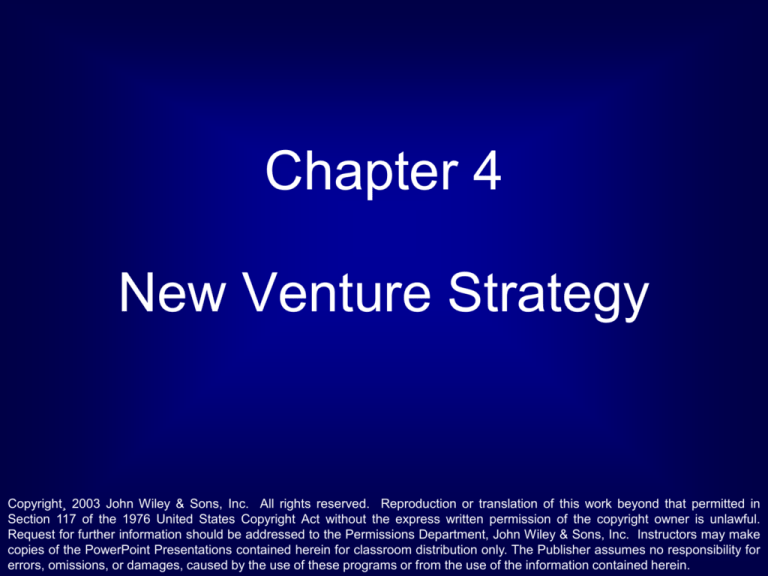
Chapter 4
New Venture Strategy
Copyright¸ 2003 John Wiley & Sons, Inc. All rights reserved. Reproduction or translation of this work beyond that permitted in
Section 117 of the 1976 United States Copyright Act without the express written permission of the copyright owner is unlawful.
Request for further information should be addressed to the Permissions Department, John Wiley & Sons, Inc. Instructors may make
copies of the PowerPoint Presentations contained herein for classroom distribution only. The Publisher assumes no responsibility for
errors, omissions, or damages, caused by the use of these programs or from the use of the information contained herein.
Learning Objectives
• Understand what makes a decision strategic.
• Understand the interrelationships between financing
decisions and other aspects of new venture strategy.
• Relate strategic decisions to the entrepreneur’s
objective of value maximization.
• Describe strategic alternatives in terms of real
options.
• Use decision trees to identify and evaluate real
options.
• Use game trees when strategic choices depend on
rival reactions.
©2003, Entrepreneurial Finance, Smith and Kiholm Smith
Chapter 4
What Makes a Plan or
Decision Strategic?
• Strategic decisions are consequential
• Strategic decisions are both active and reactive
• Strategic decisions limit the range of possible future
actions
©2003, Entrepreneurial Finance, Smith and Kiholm Smith
Chapter 4
Interactive Financial Strategy
©2003, Entrepreneurial Finance, Smith and Kiholm Smith
Chapter 4
Financial Implications of Product-Market
and Organizational Strategic Choices
©2003, Entrepreneurial Finance, Smith and Kiholm Smith
Chapter 4
An Introduction to Options
• Option - A right to make a decision in the future
• Elements of an option
– An underlying asset
– Exercise price (strike price)
– Expiration date
– European or American form
• Basic options: Calls, Puts
• Financial options
• Real options
• Complex options
– Contingent options - created by earlier action
– Options with interdependent values
©2003, Entrepreneurial Finance, Smith and Kiholm Smith
Chapter 4
The Structure of a Call Option
©2003, Entrepreneurial Finance, Smith and Kiholm Smith
Chapter 4
Realized Returns on Options
©2003, Entrepreneurial Finance, Smith and Kiholm Smith
Chapter 4
Valuing Options
• Put-Call Parity
•
•
•
– Option Pricing Models based on no-arbitrage
– Stock + Put = Call + PV(Exercise Price)
– Role of complete markets
Financial Options
– Complete markets
– Incomplete markets
Real Options
– Complete markets
– Incomplete markets
Complex Real Options (Rainbow Options)
– Discrete scenarios
– Simulation
©2003, Entrepreneurial Finance, Smith and Kiholm Smith
Chapter 4
Real Options - Some Examples
• Defer - Investing now eliminates the option to defer
(learning)
• Expand - An option to defer part of the scale of
investment
• Contract - The flexibility to reduce the rate of output
• Abandon - Stop investing, and liquidate existing assets
• Staging - Substitute a series of small investments for
one large
• Switching - Re-deploy resources or change inputs
©2003, Entrepreneurial Finance, Smith and Kiholm Smith
Chapter 4
Examples of Real Options
©2003, Entrepreneurial Finance, Smith and Kiholm Smith
Chapter 4
Techniques for Reasoning
Through Decision Trees
1. Focus on the most important decisions.
2. Reason forward to construct the tree.
3. Track certainties and uncertainties at each decision
point.
4. Calculate backward to evaluate choices.
5. Select the tree branch with the highest expected
value.
©2003, Entrepreneurial Finance, Smith and Kiholm Smith
Chapter 4
Decision Tree Example Assumptions
•
•
•
•
•
•
•
•
Demand may be high (30%), medium (50%), low (20%).
Cost of large restaurant is $750,000.
Cost of small restaurant is $600,000.
Entrepreneur will invest $400,000, outside investor
provides the rest.
Investor requires 1% of equity for each $10,000
invested.
If demand is high - PV large is $1,500,000, PV small is
$800,000.
If demand is medium - PV large is $800,000, PV small is
$800,000.
If demand is low - PV large is $300,000, PV small is
$400,000.
©2003, Entrepreneurial Finance, Smith and Kiholm Smith
Chapter 4
Accept/reject Decision to
Invest in Restaurant Business
©2003, Entrepreneurial Finance, Smith and Kiholm Smith
Chapter 4
Evaluation of Accept/Reject
Alternatives
• Large-scale entry:
NPV conditional on high demand
= $575,000
NPV conditional on intermediate demand
= $120,000
NPV conditional on low demand
= ($205,000)
NPV = .3 x $575,000 + .5 x $120,000 – .2 x
$205,000
= $191,500
©2003, Entrepreneurial Finance, Smith and Kiholm Smith
Chapter 4
Evaluation of Accept/Reject
Alternatives (Cont’d)
• Small-scale entry:
NPV conditional on high demand
= $240,000
NPV conditional on intermediate demand
= $240,000
NPV conditional on low demand
= ($ 80,000)
NPV = .3 x $240,000 + .5 x $240,000 - .2 x $80,000
= $176,000
• Do not enter:
NPV = $0
©2003, Entrepreneurial Finance, Smith and Kiholm Smith
Chapter 4
Restaurant Business Investment
With an Option to Delay Investing
©2003, Entrepreneurial Finance, Smith and Kiholm Smith
Chapter 4
Evaluation of Option to Delay
• Large-scale entry strategy: NPV = $191,500
• Delay until uncertainty is resolved:
– High demand
• Build large restaurant
• NPV conditional on high demand = $445,000
– Intermediate demand
• Build small restaurant
• NPV conditional on intermediate demand
• = $160,000
– Low demand
• Do not enter
• NPV conditional on low demand = $0
©2003, Entrepreneurial Finance, Smith and Kiholm Smith
Chapter 4
Evaluation of Option to Delay
(Cont’d)
• NPV of delay strategy:
– = .3 x $445,000 + .5 x $160,000 + .2 x $0
– = $213,500
• Value of Option to Delay = $213,500 - 191,500
– = $22,000
©2003, Entrepreneurial Finance, Smith and Kiholm Smith
Chapter 4
Restaurant Business Investment With
an Option to Expand Initial Investment
©2003, Entrepreneurial Finance, Smith and Kiholm Smith
Chapter 4
Evaluation of Option to Expand
• Large-scale entry strategy: NPV = $191,500
• Delay until uncertainty is resolved: NPV = $213,500
• Build small, with Option to Expand:
– Conditional on High demand:
• NPV if Expand = $580,000
• NPV if Remain Small = $240,000
• Conclusion: Expand if demand is high
– Conditional on Intermediate demand:
• NPV of Remaining Small = $240,000
– Conditional on Low demand:
• NPV of Remaining Small = ($80,000)
©2003, Entrepreneurial Finance, Smith and Kiholm Smith
Chapter 4
Evaluation of Option to
Expand (Cont’d)
• NPV of Small-scale entry with Option to Expand
– = .3 x $580,000 + .5 x $240,000 - .2 x $80,000
– = $278,000
• Value of Expansion Option = $86,500
• Incremental value over Delay Option = $64,500
– The Options are Mutually Exclusive
©2003, Entrepreneurial Finance, Smith and Kiholm Smith
Chapter 4
Evaluation of Option to
Abandon
• Large-scale entry strategy: NPV = $191,500
• Large-scale entry with Abandonment option:
– Convert to office with $600,000 value
– NPV of converting for entrepreneur = ($10,000)
– NPV with Abandonment Option:
• = .3 x $575,000 + .5 x $120,000 - .2 x $10,000
= $230,500
– Would pay up to $39,000 extra for location that is
convertible
©2003, Entrepreneurial Finance, Smith and Kiholm Smith
Chapter 4
Evaluation of Option to
Abandon (Cont’d)
• Small-scale entry with Expansion and Abandonment
Options:
– Convert to office with $300,000 value
– NPV of converting for entrepreneur = ($160,000)
– NPV with Abandonment Option:
• = .3 x $580,000 + .5 x $240,000 - .2 x $160,000
= $262,000
– Abandonment has negative value for the small
restaurant
– A result of discreteness of the analysis
• Conclusion: Build small with Expansion Option
– NPV = $278,000
©2003, Entrepreneurial Finance, Smith and Kiholm Smith
Chapter 4
Game Trees
• The Basics
– Players
– Order of play
– Information set
– Available actions
– Payoff schedules
• Strategic interaction
– Cooperative and Non-cooperative games
– Sequential-move game - Game tree
– Simultaneous-move game - Payoff matrix
• Nash equilibrium
• Sub-game perfection
©2003, Entrepreneurial Finance, Smith and Kiholm Smith
Chapter 4
Evaluating Strategic Games
• Specify assumptions about rival actions and
reactions.
• Develop the tree.
• Prune branches involving dominated strategies.
©2003, Entrepreneurial Finance, Smith and Kiholm Smith
Chapter 4
Entry Decision Game Tree
©2003, Entrepreneurial Finance, Smith and Kiholm Smith
Chapter 4








